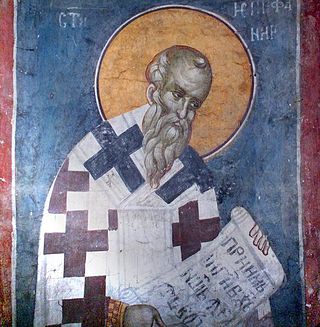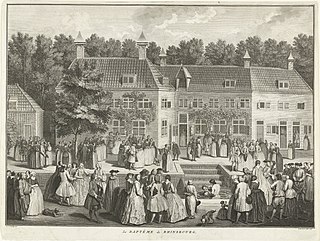Related Research Articles
In church history, the term acephali has been applied to several sects that supposedly had no leader. E. Cobham Brewer wrote, in Dictionary of Phrase and Fable, that acephalites, "properly means men without a head." Jean Cooper wrote, in Dictionary of Christianity, that it characterizes "various schismatical Christian bodies". Among them were Nestorians who rejected the Council of Ephesus’ condemnation of Patriarch Nestorius of Constantinople, which deposed Nestorius and declared him a heretic.
Nicolaism was an early Christian sect mentioned twice in the Book of Revelation of the New Testament. The adherents were called Nicolaitans, Nicolaitanes, or Nicolaites. They were considered heretical by the mainstream early Christian Church. According to Revelation 2:6 and 15, they were known in the cities of Ephesus and Pergamum. In this chapter, the church at Ephesus is endorsed for "[hating] the works of the Nicolaites, which I also hate"; and the church in Pergamos is rebuked: "So thou hast also some [worshiping in their midst] who hold the teaching of the Nicolaites". In the original Greek, they are called, in genitive, Νικολαϊτῶν (Nikolaïtōn).

The Ebionites were a Jewish Christian sect that existed during the early centuries of the Common Era,

Epiphanius of Salamis was the bishop of Salamis, Cyprus, at the end of the 4th century. He is considered a saint and a Church Father by both the Eastern Orthodox and Catholic Churches. He gained a reputation as a strong defender of orthodoxy. He is best known for composing the Panarion, a compendium of eighty heresies, which included also pagan religions and philosophical systems. There has been much controversy over how many of the quotations attributed to him by the Byzantine Iconoclasts were actually by him. Regardless of this, he was clearly strongly against some contemporary uses of images in the church.

The Nazarenes were an early Jewish Christian sect in first-century Judaism. The first use of the term is found in the Acts of the Apostles of the New Testament, where Paul the Apostle is accused of being a ringleader of the sect of the Nazarenes before the Roman procurator Antonius Felix at Caesarea Maritima by Tertullus. At that time, the term simply designated followers of Jesus of Nazareth, as the Hebrew term נוֹצְרִי, and the Arabic term نَصْرَانِي, still do.
The Cainites or Cainians were a Gnostic and antinomian sect known to venerate Cain as the first victim of the Demiurge, the deity of the Old Testament, who was identified by many groups of Gnostics as evil. The sect was relatively small. They were mentioned by Tertullian and Irenaeus as existing in the eastern Roman Empire during the 2nd century. One of their purported religious texts was the Gospel of Judas.

The Gospel of the Ebionites is the conventional name given by scholars to an apocryphal gospel extant only as seven brief quotations in a heresiology known as the Panarion, by Epiphanius of Salamis; he misidentified it as the "Hebrew" gospel, believing it to be a truncated and modified version of the Gospel of Matthew. The quotations were embedded in a polemic to point out inconsistencies in the beliefs and practices of a Jewish Christian sect known as the Ebionites relative to Nicene orthodoxy.
Barbēlō refers to the first emanation of God in several forms of Gnostic cosmogony. Barbēlō is often depicted as a supreme female principle, the single passive antecedent of creation in its manifold. This figure is also variously referred to as 'Mother-Father', 'The Triple Androgynous Name', or 'Eternal Aeon'. So prominent was her place amongst some Gnostics that some schools were designated as Barbeliotae, Barbēlō worshippers or Barbēlō gnostics.
The Basilidians or Basilideans were a Gnostic sect founded by Basilides of Alexandria in the 2nd century. Basilides claimed to have been taught his doctrines by Glaucus, a disciple of St. Peter, though others stated he was a disciple of the Simonian Menander.
Dositheos was a Samaritan religious leader. He was the founder of a Samaritan sect often assumed to be Gnostic in nature, and is reputed to have known John the Baptist, and been either a teacher or a rival of Simon Magus.
John Henry Blunt was an English divine.
The Antidicomarians or Antidicomarianites, also called Dimoerites, were a Christian sect active from the 3rd to the 5th century. Their name was invented by an opponent, Epiphanius of Salamis, who described them as heretical in his Panarion. The existence of the Antidicomarians as an organized sect may be doubted, as it is attested only in Epiphanius, but the doctrines he attributes to them were certainly matters of live debate in the late 4th century.
The Archontics, or Archontici, were a Gnostic sect that existed in Palestine, Syria and Armenia, who arose towards the mid 4th century CE. They were thus called from the Greek word ἄρχοντες, "principalities", or "rulers", by reason that they held the world to have been created and ruled by malevolent Archons.
The Arrhabonarii were a Polish Christian sect who held that the Eucharist was not a present gift of grace but was a pledge of a gift to be bestowed in heaven. The sect's name is derived from the Greek Ἀρραβων, Arrha, meaning "earnest". The position was first argued by Francesco Stancaro in 1543.
The Simonians were a Gnostic sect of the 2nd century which regarded Simon Magus as its founder and traced its doctrines, known as Simonianism, back to him. The sect flourished in Syria, in various districts of Asia Minor and at Rome. In the 3rd century remnants of it still existed, which survived until the 4th century.

In Christian history, the Collegiants, also called Collegians, were an association, founded in 1619 among the Arminians and Anabaptists in Holland. They were so called because of their colleges (meetings) held the first Sunday of each month, at which everyone had the same liberty of expounding the scripture and praying.

The Elcesaites, Elkasaites, Elkesaites or Elchasaites were an ancient Jewish Christian sect in Lower Mesopotamia, then the province of Asoristan in the Sasanian Empire that was active between 100 and 400 CE. The members of this sect, which originated in the Transjordan, performed frequent baptisms for purification and had a Gnostic orientation.
The Apotactics or Apotactites were a Christian sect in the western and southern parts of Asia Minor starting in about the third century. They were also known as Apostolics, because they attempted to follow the manner of life of the Twelve Apostles.
The Severians were a sect of gnostic Encratites. Epiphanius supposes their leader Severus to have preceded Tatian but Eusebius, Theodoret, and Jerome make him Tatian's successor. These latter authorities are followed by most ecclesiastical historians, and the silence of Irenaeus and Hippolytus regarding Severus renders the later date most probable.
References
Citations
- ↑ Blunt 1874, p. 27.
- ↑ Blunt 1874, pp. 43–44.
Books
- Blunt, John Henry (1874). Dictionary of Sects, Heresies, Ecclesiastical Parties, and Schools of Religious Thought. Rivingtons. ISBN 9781172832606.